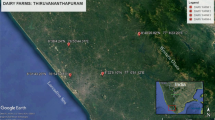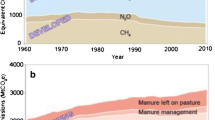Abstract
Livestock is a significant contributor to global anthropogenic emissions of methane, a short-lived greenhouse gas that is responsible for about 20% of the warming induced by greenhouse gases since pre-industrial times. India is a major contributor to these emissions, and its demand for livestock products is continually increasing in response to both growth in incomes and in population. We estimate methane emissions from livestock in India by estimating the demand for milk and milk products using countrywide representative consumption data over the period 1983–2012. We find that the average annual growth rate of methane emissions from dairy cattle is about twice as large (2.4%) as current estimates that do not take into account the economic factors that influence livestock demand. The difference in growth rates translates to an almost 40% difference in forecasted emissions from dairy cattle by 2050. Our findings suggest that, in a rapidly changing economic environment, current forecasts of greenhouse gas emissions from livestock may inaccurately estimate emissions since they fail to consider the economics governing it. We also estimate emissions under different scenarios, in terms of milk price trajectories and livestock composition. The changes in price do not alter our results significantly but the transition to crossbred animals in livestock drastically reduces future methane emissions from milk production.






Similar content being viewed by others
References
Allen J, Na-Chiangmai A (eds) (2001) Development strategies for genetic evaluation for beef production in developing countries, vol 108. Australian Centre for International Agricultural Research, Australian Centre for International Agricultural Research, Australia
Banks J, Blundell R, Lewbel A (1997) Quadratic Engel curves and consumer demand. Rev Econ Stat 79(4):527–539
Basu P (2009) Success and failure of crossbred cows in india: a place-based approach to rural development. Annals of the association of American geographers 99(4):746–766
Capper JL, Cady R, Bauman D (2009) The environmental impact of dairy production: 1944 compared with 2007. J Anim Sci 87(6):2160–2167
Capper JL, Castañeda-Gutiérrez E, Cady RA, Bauman DE (2008) The environmental impact of recombinant bovine somatotropin (rbst) use in dairy production. Proc Natl Acad Sci 105(28):9668–9673
Chhabra A, Manjunath K, Panigrahy S, Parihar J (2009) Spatial pattern of methane emissions from indian livestock. Curr Sci pp 683–689
Dangal SR, Tian H, Zhang B, Pan S, Lu C, Yang J (2017) Methane emission from global livestock sector during 1890–2014: magnitude, trends and spatiotemporal patterns. Glob Change Biol 23(10):4147–4161
Datta T, Ganguly B (2002) An analysis of consumer expenditure pattern in indian states with special reference to milk and milk products. Indian Dairyman 54 (9):47–56
Deaton A, Muellbauer J (1980) An almost ideal demand system. Am Econ Rev 70(3):312–326
Eckard R, Grainger C, De Klein C (2010) Options for the abatement of methane and nitrous oxide from ruminant production: a review. Livest Sci 130(1):47–56
FAO (2018) Fao, Food and Agriculture Organisation. http://www.fao.org/faostat/en/#data/GE
Garg A, Bhattacharya S, Shukla P, Dadhwal V (2001) Regional and sectoral assessment of greenhouse gas emissions in india. Atmos Environ 35(15):2679–2695
Kumar A, Joshi P, Kumar P, Parappurathu S (2014) Trends in the consumption of milk and milk products in india: implications for self-sufficiency in milk production. Food Security 6(5):719–726
Landes M, Cessna J, Kuberka L, Jones K (2017) India’s dairy sector: Structure, performance, and prospects, Technical Report LDPM-272-01, Economic Research Service/USDA
Morgan N (2009) Smallholder dairy development: lessons learned in Asia, Animal Production and Health Commotion for Asia and the Pacific and FAO
Myhre G, Shindell D, Bréon F, Collins W, Fuglestvedt J, Huang J, Koch D, Lamarque J, Lee D, Mendoza B et al (2013). In: Tignor MK, Allen SK, Boschung J, Nauels A, Xia Y, Bex V, Midgley PM (eds) Climate change 2013: the physical science basis. contribution of working group i to the fifth assessment report of the intergovernmental panel on climate change. Cambridge University Press, Cambridge and New York
Poi BP (2012) Easy demand-system estimation with QUAIDS. Stata J 12 (3):433–446
Ripple WJ, Smith P, Haberl H, Montzka SA, McAlpine C, Boucher DH (2013) Ruminants, climate change and climate policy. Nat Clim Chang 4(1):2
Saunois M, Jackson R, Bousquet P, Poulter B, Canadell J (2016) The growing role of methane in anthropogenic climate change, Environ. Res Lett 11(12):12
Shindell DT, Faluvegi G, Koch DM, Schmidt GA, Unger N, Bauer SE (2009) Improved attribution of climate forcing to emissions. Science 326(5953):716–718
Sirohi S, Michaelowa A (2007) Sufferer and cause: Indian livestock and climate change. Clim Chang 85(3):285–298
Smith P, Clark H, Dong H, Elsiddig E, Haberl H, Harper R, House J, Jafari M, Masera O, Mbow C et al (2014) Agriculture, forestry and other land use (afolu), Climate change 2014: Mitigation of Climate Change Contribution of Working Group III to the Fifth Assessment Report of the Intergovernmental Panel on Climate Change
Swamy M, Bhattacharya S (2006) Budgeting anthropogenic greenhouse gas emission from Indian livestock using country-specific emission coefficients. Curr Sci 91 (10):1340–1353
VDSA I (2018) Icrisat vdsa database, Website. http://www.icrisat.org/vdsa/vdsa-index.htm
Acknowledgments
We thank E. Somanathan, Jeffrey Vincent, and Parikshit Ghosh, Martino Pelli, as well as seminar participants, at the Indian Statistical Institute Delhi, UQAM, University of Gothenburg, and participants at conferences at the 6th World Congress of Environmental and Resource Economics (WCERE) in Gothenburg, 2nd Annual Workshop of the Centre for Research on the Economics of Climate, Food, Energy and Environment in Ranthambore for useful comments on the manuscript.
Author information
Authors and Affiliations
Corresponding author
Additional information
Publisher’s note
Springer Nature remains neutral with regard to jurisdictional claims in published maps and institutional affiliations.
Electronic supplementary material
Below is the link to the electronic supplementary material.
Rights and permissions
About this article
Cite this article
Gupta, R., Dasgupta, A. Milk will drive methane emissions in India. Climatic Change 161, 653–664 (2020). https://doi.org/10.1007/s10584-020-02715-4
Received:
Accepted:
Published:
Issue Date:
DOI: https://doi.org/10.1007/s10584-020-02715-4




